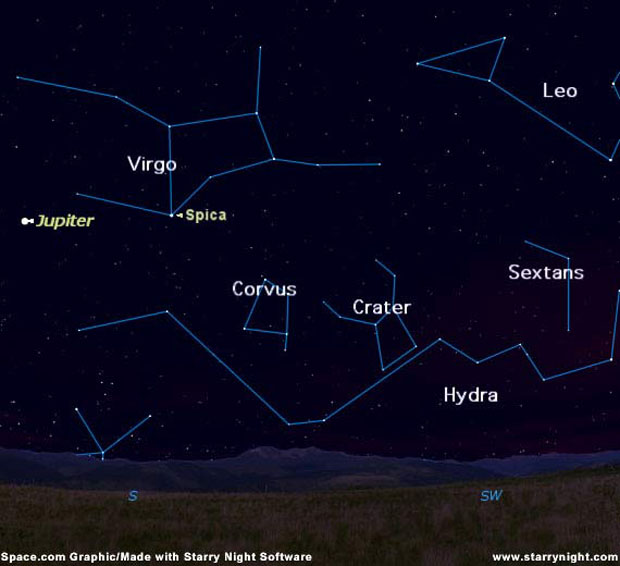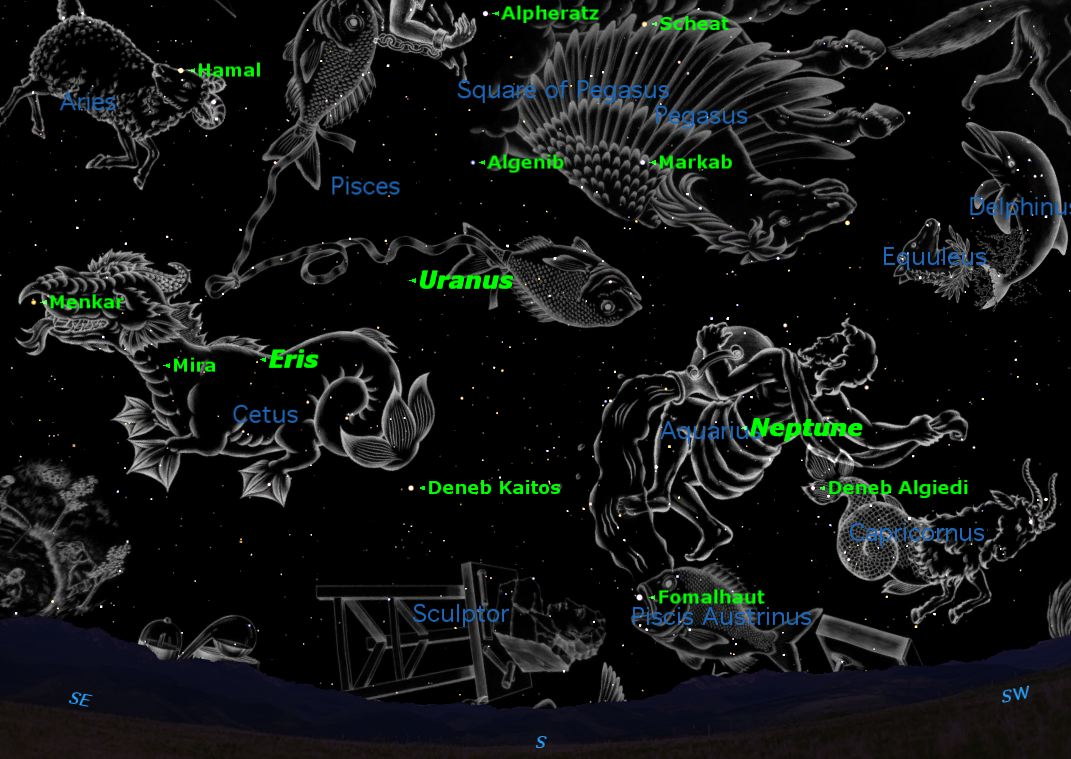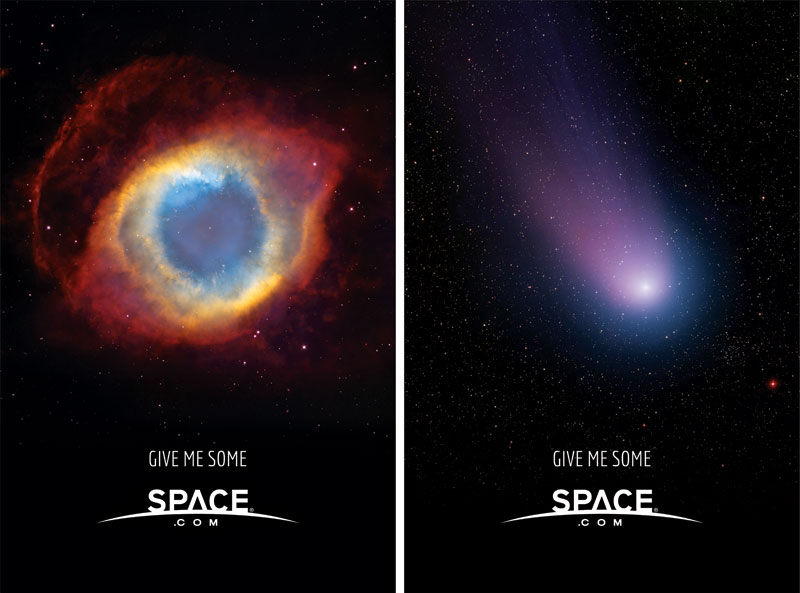
You wouldn't think that a water snake, a crow and a goblet would have any kind of connection with each other, but all three are tied together in a strange story that spans across the current evening sky.
With the bright moon now completely out of our evening sky, we can look to the south to trace one of the most extensive of all the star patterns: the long, and mostly faint, constellation Hydra, the female water snake.
A male snake bearing the name Hydrus is visible only in Southern Hemisphere sky. One of the more famous Hercules stories is how he killed a hundred-headed serpent known as the Hydra. Perhaps that's why when the constellation of Hercules stands triumphantly overhead on summer evenings, the tail of the constellation Hydra is slithering out of sight below the southwest horizon. [Constellations of the Night Sky: Famous Star Patterns (Images)]

Hydra begins just below the constellation Cancer (the Crab), with a boxy shape of five stars between the bright stars Procyon and Regulus representing the snake's head. Hydra's scraggly stream of dim stars then wriggles southeastward past its lone bright star: the ruddy second magnitude star Alphard, which appears brighter than it actually is because it has no competition. Because of that fact, Alphard is sometimes called the "Solitary One."
Hydra's long and sinuous trail of dim stars finally ends in a distant tail below the constellation Virgo, and nearly reaches Libra, the Scales, toward the east. The entire snake, running from high in the southwest sky, over toward the south and finally down low to the southeast, is in view this week beginning after about 11 p.m. your local time. Hydra slithers beneath the several other star patterns, including the faint Sextans, the Sextant; Crater, the Cup; and the brighter Corvus, the Crow.
Despite meandering across 95 degrees of the sky (and taking nearly seven hours to fully rise into view), Hydra doesn't include much of general interest to the average skywatcher. One of its stars, Epsilon Hydrae, is actually a multiple star system — a close pair that takes 15.3 years to orbit each other. Yet a third star orbits around the inner pair, and takes about 650 years to make one complete revolution.
Of the three smaller constellations sitting just above Hydra, by far the most conspicuous is Corvus, which on star charts appears as a small, moderately bright quadrilateral-shaped pattern of stars. Were we to add a fainter, adjoining star, the pattern would then resemble the battened mainsail of a Chinese junk, or lugsail, ship.
Get the Space.com Newsletter
Breaking space news, the latest updates on rocket launches, skywatching events and more!

Unfaithful fowl and a faint goblet
The constellation Corvus is supposed to represent the unfaithful raven of the god Apollo. As the legend goes, the bird was sent out with a goblet or cup for some water, but instead loitered at a fig tree until the fruit became ripe. The crow then returned to Apollo without the cup, but with a water snake in his claws, alleging the snake to be the cause of his delay. [Constellation Quiz: Do You Know Your Star Patterns?]
As punishment, the angry Apollo changed Corvus from a beautiful silvery-white to the black color that all crows and ravens bear to this day. In addition, Corvus was forever fixed in the sky along with the Cup (Crater) and the Snake (Hydra), doomed to everlasting thirst by the guardianship of the Hydra over the Cup and its contents. And this is supposedly why, of all birds, only the raven does not carry water to its fledglings.
Corvus also serves as a useful guide for anyone traveling south. Directly south of Corvus is Crux, the Southern Cross, but one must go well south — down to Brownsville, Texas, or to Miami and the Florida Keys to see this very famous southern constellation.
Crater, the Cup, is a small and rather faint figure, which corresponds quite closely to its name. Its stars indeed outline a goblet, but unfortunately they are hard to distinguish when the sky is hazy or when there is a bright moon in the sky.

And then there is Noctua (Who?)
Lastly, I should mention one other star pattern that can be found on some older star charts sitting complacently on the end of Hydra's tail. It is Noctua, Vel Avis Solitaria, or as it more simply known: the Owl.
Composed of nearly two dozen mostly faint stars, this night bird star pattern was created in 1776 by a Frenchman, Lemonier, in memory of the voyage of the famed French astronomer, Alexandre Guy Pingré to Rodriguez Isle.
Unfortunately for Lemonier and Pingré, today the Owl is no longer recognized as an official constellation. Its dim retinue of stars belonging now to Virgo and Libra. It's ironic in a way, since there are a variety of different birds that inhabit the nighttime sky, yet the bird that is most associated with the night is not one of them!
Editor's note:If you have an amazing skywatching photo you'd like to share for a possible story or image gallery, please contact managing editor Tariq Malik at spacephotos@space.com.
Joe Rao serves as an instructor and guest lecturer at New York's Hayden Planetarium. He writes about astronomy for Natural History magazine, the Farmer's Almanac and other publications, and he is also an on-camera meteorologist for News 12 Westchester, N.Y. Follow us @Spacedotcom, Facebook and Google+. Original article on Space.com.
Join our Space Forums to keep talking space on the latest missions, night sky and more! And if you have a news tip, correction or comment, let us know at: community@space.com.

Joe Rao is Space.com's skywatching columnist, as well as a veteran meteorologist and eclipse chaser who also serves as an instructor and guest lecturer at New York's Hayden Planetarium. He writes about astronomy for Natural History magazine, Sky & Telescope and other publications. Joe is an 8-time Emmy-nominated meteorologist who served the Putnam Valley region of New York for over 21 years. You can find him on Twitter and YouTube tracking lunar and solar eclipses, meteor showers and more. To find out Joe's latest project, visit him on Twitter.









